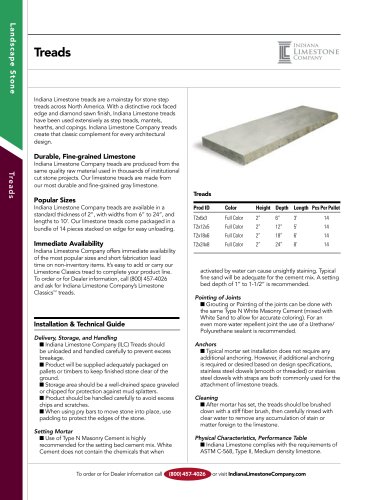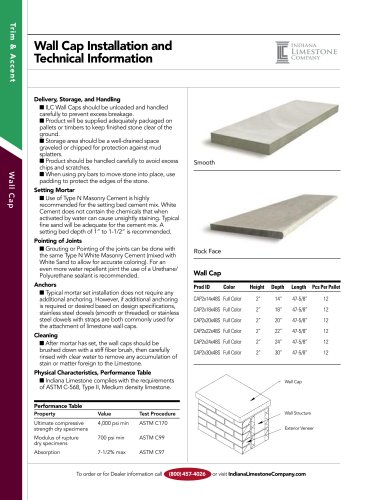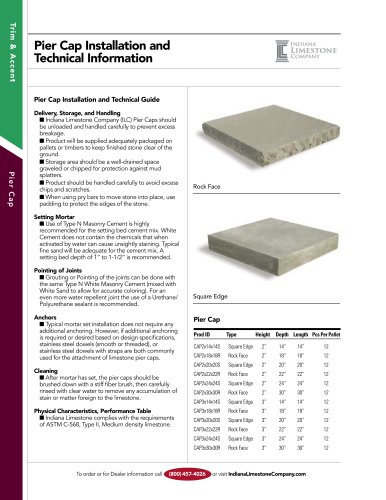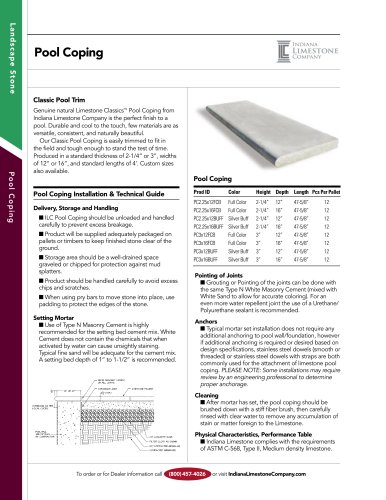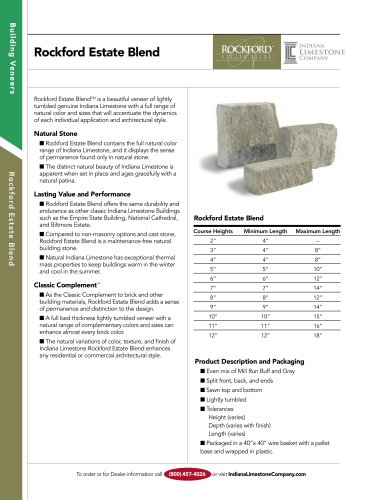 Website:
Indiana Limestone Company
Website:
Indiana Limestone Company
Catalog excerpts

Indiana Limestone Institute
Open the catalog to page 1
The Indiana Limestone Institute wishes to thank the Natural Stone Council for its generous grant, which was used to print this Handbook and to make it available for downloading from our website. TM INDIANA LIMESTONE INSTITUTE OF AMERICA, INC. STONE CITY BANK BLDG. #400 BEDFORD, IN 47421 812-275-4426 FAX 812-279-8682 Web Page http://www.iliai.com The Indiana Limestone Institute and its member companies will help users with any technical or aesthetic problem. We invite requests for assistance and will call on interested parties on request. The publication of this Handbook is made possible in...
Open the catalog to page 2
purpose of the institute ILI serves the construction industry, the architectural profession and the limestone industry as a coordinating agency for the dissemination of accurate, unbiased information on limestone standards, recommended practices, grades, colors, finishes, and all technical data required for specifying, detailing, fabricating and erecting Indiana Limestone. service to architects Help in the use of Indiana Limestone is available to architects, designers and specifiers in the selection of grade, color and finish. We offer a Review and Comment Service for preliminary drawings...
Open the catalog to page 3
SECTION I general information A Brief History of the Indiana Limestone Industry Geological Formation Chemical Analysis Product Description Seasoned Stone Physical Properties, Performance Tables, and Performance Characteristics Classification of Indiana Limestone (Grading)
Open the catalog to page 5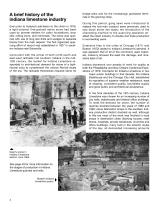
A brief history of the indiana limestone industry Even prior to Indiana’s admission to the Union in 1816, a light-colored, fine-grained native stone had been used by pioneer settlers for cabin foundations, door sills, milling burrs, and memorials. The stone was quarried with use of long star drills and wedges to separate blocks from the main deposit. The first organized quarrying effort of record was established in 1827 in southern Indiana near Stinesville. Concurrent with the arrival of both north-south and east-west railroads into southern Indiana in the mid19th century, the market for...
Open the catalog to page 6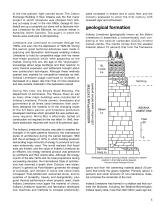
of the fine-grained, light-colored stone. The Cotton Exchange Building in New Orleans was the first major project in which limestone was shipped from Indiana cut ready to set. In the mid-1890s, George W. Vanderbilt set up a complete cut stone mill to fabricate Indiana Limestone for the Biltmore, his summer retreat in Asheville, North Carolina. The quarry in which the blocks were produced is still operating. Limestone use continued to increase through the 1920s, and even into the depression of 1929-39. During this period, great technical advances were made in quarrying and fabrication...
Open the catalog to page 7
ing the Mississippian geological epoch. This shallow sea was inhabited by a vast number of shell-protected organisms, chiefly bryozoans and echinoderms, although many members of a single genus of the foraminifers were also present. Shellfish of the brachiopods and mollusks and a few other forms of life also lived in the sea. The shells were moved, broken, crushed and ground, then redeposited through the action of the currents. Finely divided calcium carbonate was produced during this process and adhered to many shells in a series of concentric layers to form oolitic (rock egg) grains, so...
Open the catalog to page 8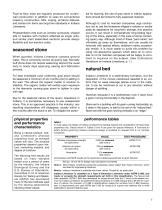
Floor-to-floor sizes are regularly produced for curtainwall construction in addition to sizes for conventional masonry construction. Sills, coping, entrance features and similar trim items are long-time standards in Indiana Limestone. Preassembled units such as window surrounds, shaped sills or headers with mullions attached as single units, and similar plant assembled sections provide design flexibility and low erection costs. seasoned stone When quarried, Indiana Limestone contains ground water. This is commonly known as quarry sap. Normally buff stone does not require seasoning beyond...
Open the catalog to page 9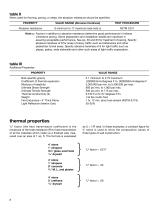
table II When used for flooring, paving, or steps, the abrasion resistance should be specified. PROPERTY VALUE RANGE (Abrasive Hardness) TEST PROCEDURE Abrasion resistance 6 minimum to 17 maximum (see note c) Note c: Factors in addition to abrasion resistance determine good performance in Indiana Limestone paving. Stone preparation and installation details are important in assuring acceptable performance. See pp. 30 and 63 for treatment of paving. Specify abrasive hardness of 8 for areas of heavy traffic such as bottlenecks and other pedestrian funnel areas. Specify abrasive hardness of 6...
Open the catalog to page 10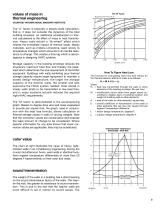
thermal engineering COURTESY INTERNATIONAL MASONRY INSTITUTE The 'IT factor is basically a steady-state calculation; that is, it does not consider the dynamics of the total building envelope. An additional consideration in ther- mal calculations is the effect of mass in heat transmis- sion. Heavy walls exhibit a "fly-wheel" effect which retards the immediate impact of thermal loads. Massy materials, such as Indiana Limestone, react slowly to temperature changes which amounts to an inertial resis- tance to change. This creates a time lag which is advan- tageous in designing HVAC systems....
Open the catalog to page 11
GRADE AND COLOR CLASSIFICATIONS sound itself does not actually flow through a wall. It simply moves the wall to reradiate sound on either side. Therefore, the transmission of sound is determined almost entirely by the weight of the wall. COLOR DESCRIPTIONS Buff—varies from a light creamy shade to a brownish buff. Gray—varies from a light silvery gray to shades of bluish gray. GRADE DESCRIPTIONS The ILI classifications are based on the degree of fineness of the grain particles and other natural characteristics which make up the stone. The structural soundness of each of the grades is...
Open the catalog to page 12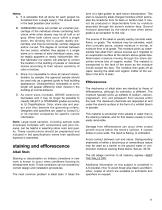
Notes: A. It is advisable that all stone for each project be furnished from a single quarry. This should result in the best possible color control. B. VARIEGATED stone will contain an uncertain percentage of the individual stones containing both colors while other stones may be all buff or all gray. When both colors occur within a single stone, the dividing line is usually readily discernible, and may be horizontal, vertical, diagonal and/or curved. The degree of contrast between the two colors, whether they appear in a single stone or in stones of solid individual colors, may be readily...
Open the catalog to page 13


